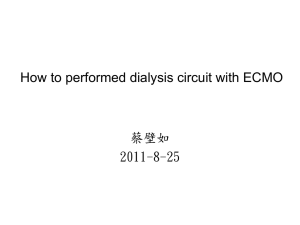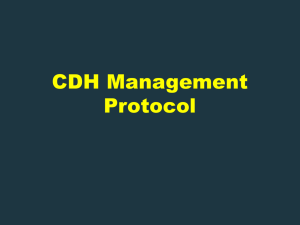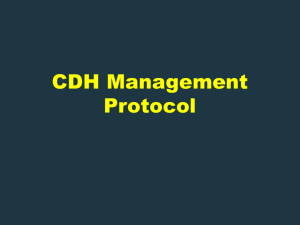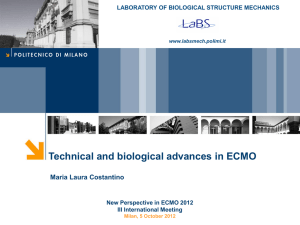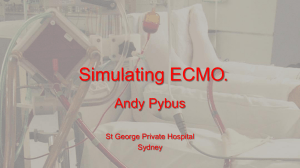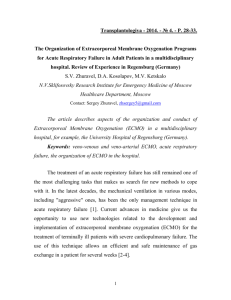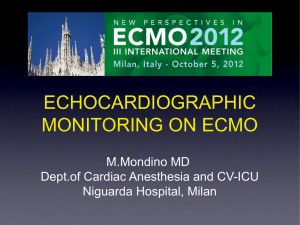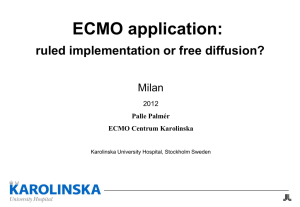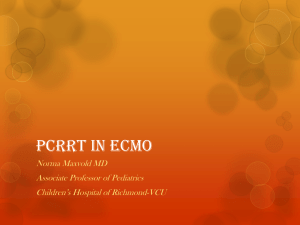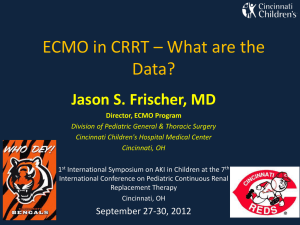Fall Workshop presentation - ECMO
advertisement
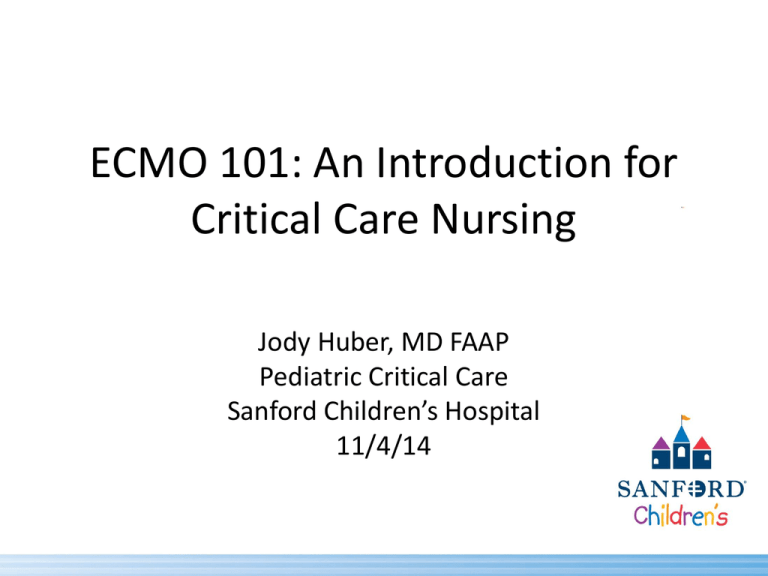
ECMO 101: An Introduction for Critical Care Nursing Jody Huber, MD FAAP Pediatric Critical Care Sanford Children’s Hospital 11/4/14 Objectives • Understand the physiology of the ECMO circuit. • Know basic indications for ECMO in infant, pediatric and adult populations. • Understand benefits and risks of anticoagulation associated with ECMO. • Understand monitoring of an ECMO patient. • Know how to respond to ECMO complications/emergencies. Outline • • • • • • • What is ECMO? How does it work Indications Modalities: V-V vs. V-A Anticoagulation Monitoring Complications Case Study #1 • • • • • • • • 8 y/o known asthmatic w/ URI 2 days PTA Night PTA used Albuterol inhaler X 10 Given 1 dose oral steroid in AM Family drove to ER BG: 7.17/77 in ER Neuro intact in ER Ketamine X 1 + BiPAP rapid deterioration SQ Epi X 3, continuous Albuterol, Terbutaline bolus & gtt started in ER Case Study #1 • Obtunded in PICU, poor air movement bilaterally • BG: 6.83/172/210/-6 • Intubated, sedated, and paralyzed • Auto PEEP 18 • Terbutaline 10 mcg/kg/min, Solu Medrol 2 mg/kg, Albuterol 20 mg/hr, Ketamine • Anesthesia consulted for initiation of Isoflurane Case Study #1 • Isoflurane started massive vasopressor support required • pH continued between 6.9 – 7.14 with CO2 139207 while intubated w/ Isoflurane x several hours • Should we try ECMO for this patient? • Can we support this patient? • How should we support this patient? Case Study #2 • 13 y/o w/ TGA s/p arterial switch and PV replacement . . . presents w/ abdominal pain, lethargy, low grade fever & vomiting x 6 days • 2/2 blood cultures (+) S. aureus 3 days PTA • Admitted locally for hypotension & thrombocytopenia • Transferred to Sanford Children’s for worsening hypotension Case Study #2 • Echo: EF 71% on left, significantly decreased RV systolic and diastolic function, RV hypertrophy, moderate TR w/ TR jet of 150 mmHg, RV to PA conduit hypoplastic, free PI, large VSD patch, no vegetations seen • CTA chest – possible vegetation on PV, multiple microemboli in lung • Meropenem & Vancomycin • ABG 7.04/27/95/-22 • WBC 36.4K (left shift), Plts 76K • HCO3 10, Alb 1.4, Lactic acid 3.3 Case Study #2 • Multiple fluid boluses • CV support: Epi 0.4 mcg/kg/min; NE 0.7 mcg/kg/min; Hydrocortisone • Mottled, cold, diaphoretic, not tolerating position changes, desaturations • Should we try ECMO for this patient? • Can we support this patient? • How should we support this patient? What is ECMO/ECLS? • Extracorporeal Membrane Oxygenation • Extracorporeal Life Support • Temporary support of heart and/or lung function using mechanical devices • Used in infants, children and adults for cardiac and/or respiratory failure • First used by Bartlett (surgeon from Univ. Michigan) in late 1970’s in neonates with respiratory failure How Does ECMO Work? • 2 Modalities: – V-V (veno-venous) – V-A (veno-arterial) • • • • Mechanical blood pump Gas exchanger Heat exchanger Circuit tubing (PVC-based plastic compound) Lequier, 2013. Cannula Placement Monitoring • Continuous values: – Venous oxygen saturation • Oxygen extraction (cardiac output) • V-V will have higher SVO2 recirculation – Arterial blood gas – Arterial oxygen saturation – ETCO2 from airway native lung function – Vital signs • Anticoagulation: – ACT hourly & platelets every 8-12H – Monitor for clots in circuit Van Meurs, 2005; Lequier, 2013. Monitoring • Blood flow = ml/kg/min • Circuit pressures – Venous access pressures – before centrifugal pump • Avoid excessive suction, adequate venous drainage & circuit volume • Bladder – Pre-membrane pressure – Post-membrane pressure • Both pressures rise obstruction to inflow cannula • Transmembrane pressure rise increased resistance in oxygenator • Pre/post oxygenator blood gas • Bubble detector by oxygenator Lequier, 2013; Butt, 2013. Continuous SVO2, ABG, SaO2 Pre and post-filter pressures Flow rate Drawing of ACT Pumps • Must provide appropriate flow for patient – 75-150 ml/kg/min = infants & children • Roller pumps – Heavy motor, tubing can wear/rupture in pump head, no limit to infusion pressure, risk of blowout – If pump flow exceeds venous drainage flow – bladder collapses and pump stops • Centrifugal pumps – Replacing roller pumps – Light & small motor, components don’t wear out, infusion pressure limited by rpm, circuit rupture uncommon – Potential for inadequate venous drainage – Afterload sensitive Lequier, 2013; Butt, 2013 Roller vs. Centrifugal Pump Oxygenators • Add O2 & remove CO2 • Hollow fiber PMP (polymethylpentene) oxygenators primarily used today – Extremely efficient at gas exchange – Minimal plasma leakage – Low resistance to blood flow – Pediatric & adult sizes – Integrated heat-exchange device Lequier, 2013. Goals of Support • Adequate blood flow for cellular metabolic needs – – – – – 100-150 ml/kg/min (higher with sepsis) SVO2 70% Lactic acid Capillary refill Urine output • Adequate oxygenation – SaO2 > 75% – Hgb > 12 gm/dl – pCO2 40 mmHg • Prevention of complications from other therapies – Lung damage from VILI – Cardiac injury from high-dose inotropes/vasopressors Van Meurs, 2005; Butt, 2013. Indications • General: Acute, severe, reversible cardiac or respiratory failure when risk of dying from primary disease despite optimal conventional treatment is high Van Meurs, 2005. Indications: Neonates • • • • • PPHN (Persistent Pulmonary Hypertension) MAS (Meconium Aspiration Syndrome) CDH (Congenital Diaphragmatic Hernia) Sepsis/pneumonia Air leak Van Meurs, 2005; Dalton, 2012 Van Meurs, 2005. Indications: Children • Severe acute respiratory failure • Sepsis • Cardiac failure – Congenital heart disease (post-operative) – Cardiomyopathy – Myocarditis • ECPR – ECMO initiated while undergoing CPR • Hypothermia re-warming • Therapeutic hypothermia Van Meurs, 2005; Dalton, 2012. Indications: Adult • • • • • • Graft failure after cardiac or lung transplantation Cardiac failure Shock Severe respiratory failure Hypothermia re-warming Therapeutic hypothermia Dalton, 2012. Dalton, 2012 Contraindications • • • • • Recent intracranial hemorrhage Embolic stroke Established renal failure Prolonged ventilation Immunocompromised* – Underlying cancer or immune defect w/ good long-term outcome – Stem cell transplant poor outcome Dalton, 2012, Jaquiss, 2013. Veno-Venous ECMO • Veno-venous ECMO = replaces function of lungs only • NO EFFECT ON HEMODYNAMICS • Oxygenated blood returns to vein & travels to heart to be circulated systemically • Recirculation = oxygenated blood returns to ECMO circuit Veno-Venous ECMO • What to do with the ventilator? – Low TV, High PEEP, low PIP’s, low FiO2, low rate, longer iT – LET THE LUNG REST! • Bronchoscopy • Surgical airway intervention Veno-Arterial ECMO • Veno-arterial ECMO = replaces function of both heart and lungs • Oxygenated blood returns to artery (bypasses heart) V-V vs. V-A V-A V-V Systemic Perfusion Circuit flow and native CO Native CO only Arterial BP Pulse contour dampened Pulse contour full CVP Not helpful Accurate guide of volume status Typical blood flow for full gas exchange 80-100 ml/kg/min 100-120 ml/kg/min Arterial oxygenation Controlled by ECMO flow 80-95% common at max flow Van Meurs, 2005. Timing of ECMO • Decrease in survival after 14 days of preECMO mechanical ventilation (60% 38%) • Pre-ECMO oxygenation index (OI) • End-organ dysfunction • Lactate > 25 mmol/L Rehder, 2013. Case Study #1 • Should we try ECMO for this patient? – Yes – reversible condition in otherwise healthy child • Can we support this patient? – Yes – hemodynamically stable but unable to clear CO2 • How should we support this patient? – Veno-venous ECMO (no need for cardiac support) Case Study #2 • Should we try ECMO for this patient? – Yes – child with repaired CHD, was previously doing well before acute illness • Can we support this patient? – Yes but hemodynamically unstable • How should we support this patient? – Veno-arterial ECMO due to poor RV function & catecholamine resistant septic shock Anticoagulation • Blood contacting non-physiologic surface = thrombosis involving a fibrin and platelet layer • Slow flow = more time for clot to form (peds) • Fast flow = less time for clot to form (adults) • Heparin infusion – most reliable & controllable anticoagulant • How does Heparin work? Van Meurs, 2005; Annich, 2013. Anticoagulation • Monitoring – ACT = Activated Clotting Time • Only POC test for anticoagulation • Measures clotting of whole blood – Anti-Xa • Measure of Heparin effect – aPTT • Plasma test activated by phospholipids – Thromboelastography • Analyze different phases of anticoagulation • Newer methods: – Heparin-bonded circuits • Goals: – Bolus w/ initiation of ECMO (50-100 U/kg) – Goal ACT 180-200 seconds – Measure AT levels? Van Meurs, 2005; Annich, 2013. Machine Emergencies/Complications • • • • • • • Thrombosis – most common Cannula problems Air embolism Oxygenator failure Tubing rupture Heat exchanger malfunction Pump failure/cutting out – Hand crank! • Accidental decannulation Van Meurs, 2005; Butt, 2013. Van Meurs, 2005. What to do in an Emergency? Van Meurs, 2005. Patient Emergencies/Complications • Bleeding – Local vs. systemic – Systemic anti-fibrinolytics (Amicar) • Neurologic – hemorrhage or ischemic stroke – HUS/HCT – Avoid HTN • Infection • Hemolysis • Acute kidney injury Van Meurs, 2005; Butt, 2013. Is Nursing Care Different? • Respiratory – – – – Lung rest – low TV, high PEEP, low rate, low FiO2 Routine suctioning Have emergency ventilator settings available Equal breath sounds on assessment • Neurological – Neuro exam including pupils – Minimize sedation if possible • Cardiac – – – – Avoid high-dose vasopressors Avoid HTN Perfusion/pulses Pulse pressure may be minimal if on full V-A support Van Meurs, 2005; Schwartz, 2013. Is Nursing Care Different? • Urine output/fluid balance – Fluid removal is a balance – Venous drainage dependent on preload – watch venous pressure – “chattering” • • • • Skin care Bleeding/oozing ECMO is keeping patient alive – vigilance If patient comes off circuit job is to care for patient & let ECMO tech manage circuit • Psychosocial support Van Meurs, 2005; Schwartz, 2013. Prognosis/Outcomes Dalton, 2012. Prognosis/Outcomes • Survival: – – – – – Neonatal CDH 51% Neonatal sepsis: 72% Pediatric sepsis: 40% Pediatric Immunodeficiency: 31% Adolescent sepsis: 31% • Long-Term Outcomes: – Neonatal: 6-13% severe neurological deficits – Pediatric respiratory failure: 16% severe neurological deficits Van Meurs, 2005; Rehder, 2013. Follow-up Case Study #1 • • • • • Veno-venous (Avalon cannula) ECMO x 7 days CO2 cleared quickly Extubated after 10 days Doing well Followed closely with Peds Pulmonology Follow-up Case #2 • Veno-arterial ECMO • Repair of Pulmonary valve after clearance of endocarditis • In rehabilitation now but overall doing well What we did not discuss . . . • • • • Inflammation secondary to ECMO Weaning off ECMO Decannulation Ethics References 1. 2. 3. 4. 5. 6. 7. 8. Van Meurs, et al. ECMO: Extracorporeal Cardiopulmonary Support in Critical Care, 3rd Ed. 2005. Rehder KJ et al. Extracorporeal Membrane Oxygenation for Neonatal and Pediatric Respiratory Failure: An Evidence-Based Review of the Past Decade (2002-2012). Pediatr Crit Care Med. 2013; 14:851-861. Dalton, HJ et al. Extracorporeal life support: An update of Rogers’ Textbook of Pediatric Intensive Care. Pediatr Crit Care Med. 2012; 13:461-471. Jaquiss, RD et al. An overview of mechanical circulatory support in children. Pediatr Crit Care Med. 2013; 14:S3-S6. Lequier, L et al. Extracorporeal Membrane Oxygenation Circuitry. Pediatr Crit Care Med. 2013; 12:S7-S12. Butt W et al. Clinical Management of the Extracorporeal Membrane Oxygenation Circuit. Pediatr Crit Care Med. 2013; 14:S13-S19. Annich, G et al. Anticoagulation for pediatric mechanical circulatory support. Pediatr Crit Care Med. 2013; 14:S37-S42. Schwartz S et al. Medical and nursing care of the child on mechanical circulatory support. Pediatr Crit Care Med. 2013; 14:S43-S50. Thank you!

